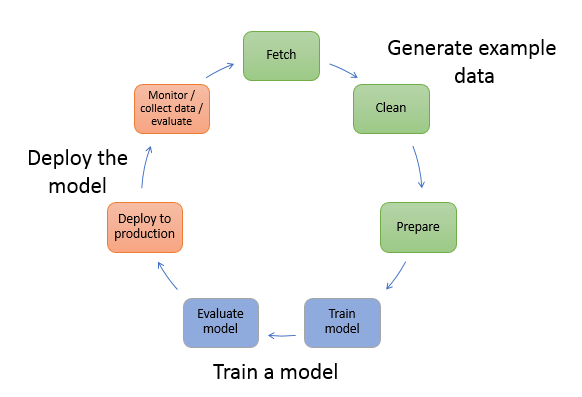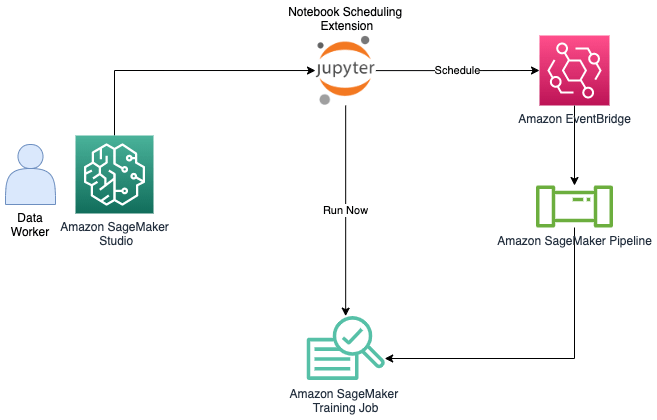
- Introduction to AWS SageMaker
- Building, Training, and Deploying Models
- How AWS SageMaker Works
- Key Features of AWS SageMaker
- Use Cases of AWS SageMaker
- SageMaker Studio and Notebooks
- Pricing and Cost Considerations
- Getting Started with AWS SageMaker
- Conclusion
Introduction to AWS SageMaker
Amazon Web Services (AWS) offers a suite of machine learning (ML) tools designed to simplify the end-to-end process of developing, training, and deploying machine learning models. Among these tools, AWS SageMaker stands out as a fully managed service that enables developers and data scientists to quickly build, train, and deploy machine learning models at scale. Amazon Web Services Training removes many complexities and challenges typically associated with machine learning, making it easier for individuals and organizations to integrate AI into their business processes.
AWS SageMaker is a robust, cloud-native solution that accelerates the development of ML models, leveraging the power of infrastructure and services. Whether you’re just starting with machine learning or working on complex AI models, AWS SageMaker offers an all-in-one platform to streamline the process. In this guide, we will explore SageMaker’s key features, how it works, its core components, use cases, pricing considerations, and how to get started with the service.
Building, Training, and Deploying Models
With AWS SageMaker, building, training, and deploying machine learning models is streamlined. Here’s how each step can be handled:
1. Building ModelsAWS SageMaker provides a variety of tools and algorithms for building ML models, whether you are using built-in algorithms or bringing your own.
- You can use SageMaker Studio to write Python scripts, manage notebooks, and track your work.
- SageMaker also integrates with Boost AWS Storage Speed with High IOPS Solutions, providing an interactive data exploration and model development environment.
- You can use SageMaker JumpStart, which offers pre-built solutions and templates for various ML tasks, including classification, regression, and natural language processing (NLP). 2. Training Models
- Automatic Model Tuning: SageMaker can automatically search for optimal hyperparameters for your model.
- Distributed Training: Scale the process with SageMaker Distributed Training, which speeds up model training using multiple EC2 instances. 3. Deploying Models
- Real-Time Endpoints: Deploy models to an endpoint for real-time predictions.
- Batch Transform Jobs: Perform batch predictions if real-time performance is not required.
Training models can be time-consuming, especially when dealing with large datasets. AWS SageMaker automates much of the heavy lifting, allowing you to focus on the model itself.
Deploying models to production is one of the most critical stages of the machine learning workflow. SageMaker simplifies deployment by offering:

How AWS SageMaker Works
AWS SageMaker works by abstracting much of the complexity of machine learning tasks, offering a high-level platform that integrates various tools for building, training, and deploying models. Let’s break down the core components and steps involved in using AWS SageMaker:
1. Data Preparation
The first step in any machine learning workflow is AWS Elastic File System Pricing Features and preparing data. AWS SageMaker makes this process easier by providing integrated tools:
- SageMaker Ground Truth can help with data labeling.
- SageMaker Data Wrangler simplifies data preparation tasks, such as cleaning, transforming, and visualizing data.
- Once the data is prepared, it can be uploaded to Amazon S3, the primary storage solution for training data in AWS. 2. Model Building
- Built-in Algorithms: AWS SageMaker provides several built-in algorithms for supervised and unsupervised learning, including linear regression, XGBoost, and image-classification algorithms.
- Custom Algorithms: You can bring your own custom algorithm and framework using pre-built Docker containers that support popular machine learning frameworks such as TensorFlow, PyTorch, MXNet, and Chainer.
After the data is prepared, you can start building machine learning models. SageMaker provides several ways to do this:
Dive into AWS by enrolling in this AWS Certification Training today.
-
3. Model Training
- Automatic Model Tuning (Hyperparameter Optimization) allows SageMaker to adjust the model parameters automatically to improve performance.
- Distributed Training allows training large models across multiple GPUs or instances to scale quickly. 4. Model Deployment
- SageMaker Endpoints: Fully managed, real-time inference endpoints that allow you to deploy models at scale.
- Batch Transform: SageMaker offers Batch Transform for AWS Elasticsearch on large datasets, which can run predictions more cost-effectively than real-time inference. 5. Monitoring and Maintenance
- SageMaker Clarify helps ensure your model’s predictions are explainable and fair.
Once you have a model, the next step is training it. SageMaker provides several features to optimize training:
After training a model, it’s time to deploy it to production. SageMaker makes deployment seamless by providing the following:
Once deployed, models require constant monitoring and optimization to ensure they continue to perform well. SageMaker Model Monitor continuously tracks the performance of deployed models, providing insights into model drift or data skew.
Key Features of AWS SageMaker
AWS SageMaker has many features that make it a powerful choice for beginners and advanced machine-learning practitioners. Here are some of the key features that make SageMaker stand out:
-
1. End-to-End Machine Learning Pipeline
- Data Labeling: SageMaker Ground Truth allows you to label data for training machine learning models. AWS Rekognition How Face Recognition Works supports human labeling tasks, making it easy to build labeled datasets.
- Data Processing: SageMaker includes various tools for data processing and feature engineering, such as SageMaker Data Wrangler, which helps prepare data for training.
- Model Building and Training: SageMaker offers built-in algorithms, pre-built containers for popular frameworks (e.g., TensorFlow, PyTorch), and an easy-to-use interface for training custom models.
- Model Deployment: After training, SageMaker can automatically deploy models to production with SageMaker Endpoint, allowing for real-time predictions at scale. 2. Automatic Model Tuning
- SageMaker Model Monitor allows you to monitor models in production, ensuring they remain accurate and detecting data drifts.
- SageMaker Clarify: Provides explainability for machine learning models, helping users understand how their models make predictions and ensuring they are fair and unbiased.
SageMaker provides a comprehensive suite of tools that cover the entire ML lifecycle. From data preprocessing to model deployment, the service helps users at each stage:
SageMaker offers automatic model tuning through its Hyperparameter Optimization (HPO) feature. This allows the service to automatically search for the best hyperparameters, improving the model’s performance without requiring manual intervention. HPO saves time and ensures the models are optimized for accuracy.
3. Managed InfrastructureAWS SageMaker handles the underlying infrastructure, removing the need to manage servers, storage, or networking. You can quickly scale your resources up or down based on the size of your data or the complexity of your models. SageMaker runs in a fully managed environment, so users don’t need to worry about provisioning and managing hardware.
Learn the fundamentals of AWS with this AWS Certification Training .
4. Integrated Jupyter NotebooksSageMaker provides fully integrated notebooks with the platform, allowing users to experiment with different ML models and data sets. SageMaker’s Jupyter notebooks offer a flexible and interactive environment for data scientists to explore data, create models, and visualize results without configuring an external notebook environment.
5. Distributed TrainingSageMaker supports distributed training of large-scale models, allowing users to accelerate training using multiple instances or GPUs in parallel. Understanding AWS Step Functions feature helps data scientists scale their training workflows across large datasets, significantly reducing training time.
6. SageMaker StudioSageMaker Studio is a fully integrated development environment (IDE) that provides a rich, user-friendly interface for building, training, and deploying machine learning models. The IDE offers an interactive UI that lets users access notebooks, code, and data, track experiments, monitor model performance, and manage training jobs seamlessly.
7. Model Monitoring and ExplainabilityAfter deploying machine learning models, SageMaker offers tools for continuous monitoring and explaining model predictions:
Use Cases of AWS SageMaker
AWS SageMaker is versatile and can be used for a wide variety of machine-learning applications across different industries.
1. Predictive MaintenanceManufacturing companies can use SageMaker to predict when their machinery might fail. By analyzing sensor data, SageMaker models can predict failures before they happen, helping organizations reduce downtime.
2. Customer PersonalizationE-commerce businesses can use SageMaker to build recommendation engines that provide personalized shopping experiences for users based on their behavior and preferences.
3. Fraud DetectionFinancial institutions can leverage SageMaker to build models that detect fraudulent transactions by analyzing patterns in AWS Training .
4. Natural Language Processing (NLP)SageMaker supports building models for NLP tasks such as text classification, sentiment analysis, and language translation, making it a powerful tool for organizations that deal with large amounts of unstructured text data.
Take charge of your AWS career by enrolling in ACTE’s AWS Master Program Training Course today!
SageMaker Studio and Notebooks
SageMaker Studio is an integrated development environment (IDE) for machine learning. Its single interface combines all the necessary tools for building, training, and deploying machine learning models.
1. SageMaker Studio Features- Centralized Workflow Management: SageMaker Studio lets you organize and track your work, keeping your notebooks, datasets, and code in one place.
- Collaboration: Multiple team members can collaborate on the same project, with the ability to share notebooks and experiment results.
- Tracking Experiments: SageMaker Studio makes tracking different experiments easy, comparing performance metrics and visualizing training runs. 2. Notebooks
- Explore data
- Develop and test models.
- Visualize results
SageMaker also provides Jupyter Notebooks, which are fully managed and integrated into the platform. AWS Blockchain Services for Secure Transactions notebooks offer an interactive environment for data scientists to:
Notebooks in SageMaker can be spun up with just a few clicks and scaled as needed, depending on the size and complexity of your tasks.

Pricing and Cost Considerations
AWS SageMaker pricing uses various resources, including compute instances, storage, and data transfer. The cost is primarily determined by:
- Training costs: This depends on the number of instances, the type of instance (e.g., CPU or GPU), and the duration of the training.
- Hosting costs: Deploying models to real-time endpoints incurs a fee based on instance type and usage.
- Storage costs: Storing models, datasets, and results in Amazon S3 incurs storage fees.
- Data transfer: Charges apply for transferring data between regions or from SageMaker to other AWS services.
Monitoring and managing resources efficiently is important to avoid unnecessary costs. AWS provides a pricing calculator to help estimate costs based on usage.
Want to ace your AWS interview? Read our blog on AWS Interview Questions and Answers now!
Getting Started with AWS SageMaker
To get started with AWS SageMaker, follow these steps:
- Create an AWS Account: If you don’t already have one, sign up for an Edge Computing With AWS Greengrass.
- Set Up SageMaker Studio: Launch SageMaker Studio from the AWS console, where you can create notebooks, experiment with models, and manage your machine learning workflow.
- Prepare Your Data: Upload your data to Amazon S3 or use SageMaker Ground Truth for data labeling.
- Build and Train Models: Use built-in algorithms or bring your models and use SageMaker’s tools for training.
- Deploy and Monitor Models: After training, deploy models to real-time endpoints or batch jobs and monitor their performance.
AWS SageMaker simplifies the machine learning lifecycle, allowing users to focus on model development and deployment, reducing infrastructure and operational overhead.
Conclusion
AWS SageMaker streamlines the entire machine learning lifecycle, making it easier for both beginners and experienced professionals to develop, train, and deploy models. With AWS Training comprehensive set of tools for data preparation, automated training, scalable deployment, and continuous monitoring, SageMaker eliminates infrastructure complexities and accelerates AI adoption. Whether used for predictive analytics, NLP, or fraud detection, SageMaker empowers businesses to harness machine learning effectively, driving innovation and data-driven decision-making.





